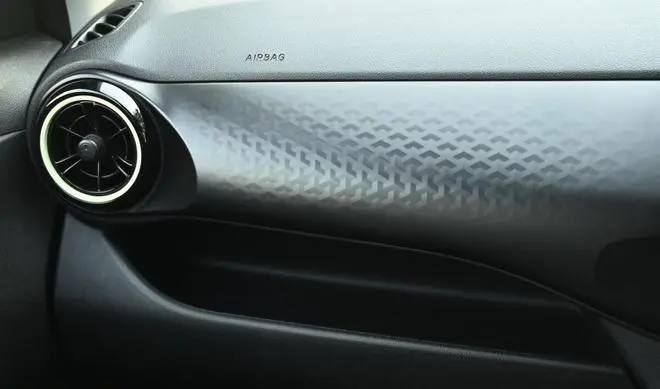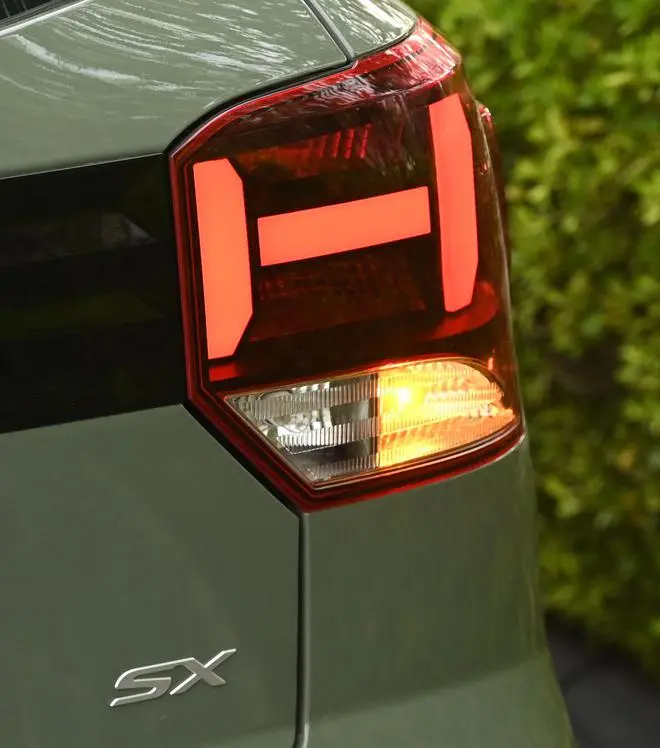The entry affordable small car segment hasn’t seen many fresh launches during the last few years. The lack of a range of interesting, aspirational new vehicles in this segment (approximately ₹6 lakh plus) has driven many buyers to pick and choose from the used car market instead. With the whole sports utility vehicle craze still raging, one of the recent sub-compact SUVs that has become popular is the Tata Punch. The lines are being blurred between the sub-compact (3,800mm +/-) and the compact segment (4,000mm +/-) SUVs. Buyer expectations are also merging between the two segments, and this makes it the perfect time for car makers to leverage the opportunity and bring some disruption into the affordable car category.

The taller roof takes the Exter’s height to 1,631mm (+111mm), and the width is marginally more at 1,710mm; mostly from the completely different design for the body panels compared to the Grand i10 Nios
Hyundai’s new sub-compact SUV Exter has been awaited and it is going to be followed by other competing brands soon joining the battle for the entry urban small car market. Is the Exter likely to shake up this market and set the benchmarks for others to try and match? Does the Exter offer entry small car buyers a credible SUV ownership experience? And is it an aspirational buy in the affordable category, where buyers currently must settle for hatches that don’t quite feel special enough?
Build
One of the other emerging aspects about buyer expectations is safety, and today consumers are voting with their wallets for vehicles that are 5-star rated. When more stringent regulations kick in, there will be an inevitable move towards adding more safety tech in Indian models. But, during the development process for the Exter, Hyundai engineers chose to work on a borrowed platform and reengineer it to ensure that the vehicle’s safety parameters are good enough to excel in rating tests. In fact, Hyundai India plans to voluntarily offer the Exter to be tested for Global NCAP rankings.

While the raised body stance and prominent haunch enhance its SUV character, the relatively small 15-inch rims don’t quite gel in
The Exter has been built on the same platform as the Grand i10 Nios. This is a tried and tested platform, which has been adapted for the stiffer and taller top-hat that the SUV body style of the Exter needs. So, while much of the work has been focused on making the passenger cell safer, Hyundai engineers decided to retain the dimensions of the Grand i10 Nios for the Exter, except the height. The taller roof takes the Exter’s height to 1,631mm (+111mm), and the width is marginally more at 1,710mm; mostly from the completely different design for the body panels compared to the Grand i10 Nios. But the wheelbase and the total length of the two vehicles are identical at 2,450mm and 3,815mm respectively. The Exter is also marginally heavier than the Grand i10 Nios (about 50kg), with much of that extra weight coming from the increased use of high strength steel for the chassis. The chassis and the underpinnings themselves remain largely unchanged in terms of the structure. Strengthening of some of the members and sub-frames has been done for increased crash safety and for incorporating additional features. Hyundai officials tell me that the suspension set up is also similar, though tuning is different, allowing for more travel and offering a slightly stiffer setting to handle the higher ground clearance (185mm) and the mild increase in weight.
Design
For a vehicle that shares much under the skin with the Grand i10 Nios, the Exter’s design is almost entirely new. There is a strong SUV flavour in the design language, though it is obviously small. The design tries successfully to distract from the Exter’s small footprint. The raised hood line that’s almost parallel to the ground, the bonnet mildly reminiscent of a clamshell, the headlamps with the H-shaped LED DRLs and the faux skid plate under the fender make the front design distinct and very SUV-like. The vertical, elongated grille with its parametric design and the black garnish connecting the two pilot lamp housings add to the perception of width and as do the main projector headlamps that are positioned on rectangular chrome framed housings on either side of the grille. The side profile has also been smartly designed to mimic the stance of a SUV. The squared-off wheel arches, with their brow-like creases higher up on the body panels, the recessed black cladding and the tall roofline contribute to this image of a strong sub-compact SUV. The thick C-pillar with its slightly awkward split parametric design panel is a giveaway to the Exter’s roots. And while the raised body stance and prominent haunch enhance its SUV character, the relatively small 15-inch rims don’t quite gel in. But the special finish for the dual tone alloys in my test mule helped redeem the flavour of the design. At the rear, the tailgate is all-new, and the LED light signature has been adopted into the tail-lamps too, giving the design consistency and distinctiveness. The thick connecting band between the tail-lamps sports the parametric geometric pattern. The roof rails, faux skid plate in the rear fender, the unique roof spoiler and the wide haunches make the Exter’s rear quite interesting for an entry-segment sub-compact SUV. Opening the upright tailgate gives one access to the 391-litre boot area.

The aircon vents, the dashboard IP, the door panels, and the door handles have all been picked out of the Grand i10 Nios parts bin.
Cabin
While the exterior of the Exter only has mild hints as to its shared platform, the cabin has more obvious design cues that point to the fact that much has been borrowed from the Grand i10 Nios. The dashboard has quite a few elements that are similar. But Hyundai designers have smartly used different materials and alternate textures and patterns to give the Exter cabin some differentiators. Most of the dashboard’s panels and features have been carried into the Exter’s cabin. The aircon vents, the dashboard IP, the door panels, and the door handles have all been picked out of the Grand i10 Nios parts bin. The colour themes are different and some of the trim elements sport a different finish. The top trim Exter SX(O) that I was driving also had drilled metal pedals and ambient lighting for the footwell. The 3-spoke steering wheel with stitched leatherette finish also looked like it has been shared. The digital instrument cluster with 4.2-inch TFT MID display had a few variations. There is also the addition of a tyre pressure monitoring system in the Highline trim. Premium floor mats are standard. There are also 60-plus connected car features that can be used through Hyundai’s Bluelink app. One novel addition is the dashcam with dual cameras to record realtime video of both on-road and in-cabin conditions. Safety features on offer include six airbags, electronic stability, vehicle stability management, hill-assist, and tyre pressure monitoring.

The digital instrument cluster with 4.2-inch TFT MID display had a few variations
Performance
For the powertrain, Hyundai engineers have again chosen to dip in and pick out its trusted workhorse — the 1.2-litre Kappa petrol with the same 5-speed manual and AMT gearboxes that are already being offered with the Grand i10 Nios. The engine has been tried and tested across other models like the Aura, i20 and Venue too. Though the gear ratios and the mapping for the powertrain have been tweaked for the Exter, the 1,197cc engine is being offered in the same state of tune as in the Grand i10 Nios. Peak power output is 83PS and peak torque is 113.8Nm. This is one of the most refined small displacement engines in the entry segment and it doesn’t disappoint in the Exter either. The NVH (noise, vibration, harshness) packaging is excellent, leading to an extremely quiet cabin on the highway. There is minimal road and tyre noise, and the firewall has been nicely insulated against engine noise. The engine noise levels do get loud when the needle gets near the 4,500rpm mark. In terms of acceleration and on-road performance, the Exter feels as quick as any of the other vehicles that feature the same mill. In fact, it is probably a little lighter than some of the others, and Hyundai engineers have been a bit less frugal with the throttle-mapping. Acceleration is very linear but feels more eager (in comparison to Grand i10 Nios).

My test mule during the official media drive in Jaipur was the top trim Exter SX (O) AMT. This automated manual transmission features electric actuators for clutch engagement and gearshifts, and this has enabled Hyundai to offer a segment-first feature in steering-mounted paddle shifters for an AMT. The gearbox is certainly more refined in its performance compared to the average AMT in the market. Under hard acceleration, there is a gap between gears being engaged and this does lead to a bit of head-nodding shifts. But manual gear selection via the stick or paddles can help in pre-emptively shifting into the right gear. On clean black-top, the ride quality is just right for a sub-compact SUV, and on rural roads and broken tarmac too it is surprisingly sorted despite its sub-compact footprint and high ground clearance. Body roll is well-contained.
Bottom Line
The new Hyundai Exter is also being offered with the same bi-fuel petrol-CNG option in the 1.2-litre Kappa engine like in the Grand i10 Nios. So that buyer is also covered. The bi-fuel version is also set to the same state of tune and paired with the 5-speed manual. This powertrain’s output is 69PS and 95.2Nm. The ARAI-rated mileage for the petrol only manual and AMT variants are over 19kmpl, and for the bi-fuel it is 27km per kg of gas.
Across all its variants, Hyundai claims the Exter delivers more features and more value over the Tata Punch, its closest rival. Introductory prices for the new Hyundai Exter range from ₹5.99 lakh to ₹9.99 lakh.






Comments
Comments have to be in English, and in full sentences. They cannot be abusive or personal. Please abide by our community guidelines for posting your comments.
We have migrated to a new commenting platform. If you are already a registered user of TheHindu Businessline and logged in, you may continue to engage with our articles. If you do not have an account please register and login to post comments. Users can access their older comments by logging into their accounts on Vuukle.